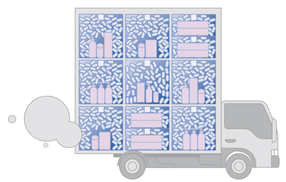Maximizing Packing & Shipping Efficiencies at a Global Scale
The case for maximizing packing & shipping efficiencies at a global scale and how 3D millimeter wave imaging can help.
Implementing efficient shipping processes across supply chains has been a priority since the beginning of digitization, but relatively few supply chain operators (including retailers, e-commerce companies, and 3PLs) have unlocked the full potential of these technologies. Since the onset of COVID-19, multi-year adoption timelines are no longer viable, as organizations have been forced to make drastic changes within a matter of months.
DHL’s 2020 Logistics Trend Radar Report highlights the critical need for improving shipping process efficiency in today’s logistics industry. This includes shifts in practices that create an immediate and positive financial and environmental impact for supply chains and businesses at a larger scale. This is an area where 3D millimeter wave imaging technology can help. By using ThruWave’s 3D imaging solution users can visualize problem areas and identify efficient packaging methods, including those needs can now be addressed more quickly to support the rapid pace of digital transformation.
Packing Efficiency & the Impact on Shipping Costs
E-commerce retailers saw an influx of $347 billion from online sales between January and September 2020, resulting in a dramatic spike in demand for shipping materials such as cardboard boxes and package fillers as compared to the same period in 2019. This left retailers and third-party logistics (3PL) providers faced with the challenge of balancing both customer expectations and making responsible packaging decisions simultaneously.
Prior to the COVID-19 pandemic, it was estimated that the average e-commerce package contained 40% or more void space. Thus, most customers have repeatedly had the experience of ordering a small item but receiving a noticeably over-sized shipping box. This can lead to an immediate negative perception among today’s eco-conscious customers. The industry-wide data show that 15% of corrugated usage and 40% of filler material usage could be eliminated through improvements in packing efficiency.
Whether an e-commerce retailer runs its own fulfillment centers or contracts with a 3PL provider for fulfillment, shipping costs are fundamentally driven by both weight and volume, or dimensional weight (DIM weight). To put this in perspective, in 2019 Amazon alone reported shipping costs of $9 billion – much of which can be attributed to unnecessary volume passing through its shipping networks.
Reducing Carbon Footprint Through More Efficient Packaging
DHL’s 2020 Logistics Trend Radar Report also highlights the need for packaging practices that result in reduced environmental impacts through the use of technology. Given the rapid growth in e-commerce shipments (currently approaching 15% CAGR) it’s clear that current efficiency levels for outbound shipments could easily result in irreversible climate harm due to the ever-increasing shipment volume and the excess carbon footprint of the required packaging.
Companies like IKEA are leveraging biodegradable packaging materials to combat this problem. Others, including Colgate and Coca-Cola, have committed to achieve 100% recyclable packaging by 2025. And another very powerful way the climate impact can be mitigated is by dramatically increasing the efficiency of packaging material by reducing the packaging material used.
Increasing the efficiency of individual shipments also leads to more efficient use of delivery vehicles as more goods can be packed into each load, thus reducing the carbon footprint of the transportation element. For example, if a package is only 40 percent full at the time of shipment, that equates to a delivery truck or cargo hold that is nearly 60 percent empty. With medium- and heavy-duty trucks and aircraft making up more than
30 percent of carbon emissions in transportation, efficient packaging has the potential to substantially reduce our carbon footprint.
Maximizing Efficiencies at a Larger Scale
As e-commerce demand skyrockets, logistics providers also have the opportunity to enable more efficient and profitable business models. The introduction of automation by logistics providers and retailers is key to making these models achievable.
Using the comprehensive shipping efficiency datasets generated by ThruWave’s millimeter wave sensors, warehouse management systems (WMS) and warehouse execution systems (WES) are capable of identifying which practices are more labor-intensive than others, particularly through the use of technology such as vision picking or robotic carts. When a robotic cart is sent to a particular aisle and shelf to retrieve a tote filled with items for an order, it is at that point that packaging decisions can be made to maximize efficiency. Using technology that can select a box size and the appropriate packing materials eliminates the need for these decisions to be made by warehouse employees, freeing them to perform higher-value operations that cannot be automated.
Improve Shipping Efficiency with ThruWave
ThruWave’s millimeter wave technology has been carefully designed to address these challenges and impacts of inefficient packaging across supply chains. ThruWave’s X2 Millimeter Wave Imaging System enables high-speed 3D imaging of objects through non-metallic packaging materials such as cardboard, paper, plastic, fabric and wood – meaning packages delivered to end-users can be placed into boxes selected or constructed specifically to fit those items, eliminating the majority of wasted packaging space. The X2 Millimeter Wave Imaging System also integrates seamlessly with WMS and Enterprise Resource Planning (ERP) systems to enhance process efficiencies across broad categories of logistics operations.
Enhanced visibility is key in creating more efficient packaging practices across the e-commerce and logistics industries. Through the integration of ThruWave’s mmWave technology, it is now easier than ever before to gain real-time insights – reducing shipping costs and minimizing carbon footprints, while simultaneously increasing supply chain efficiency.
Recent ThruWave News and Resources





